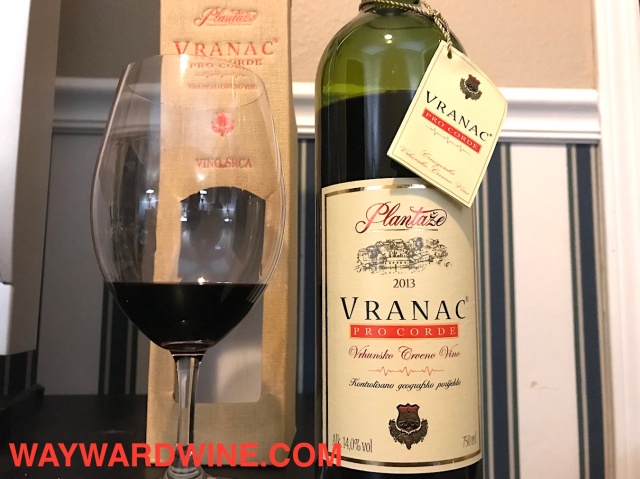Be good to your mother-in-law. You never know when she might share wines smuggled from the Balkans. After our New Year’s Eve Serbian bubbly (read here), today we try a serious red wine from Montenegro: a country sandwiched between the Adriatic Coast, inland Serbia, Bosnia and Croatia to its North, Albania and Kosovo to its South.
This wine’s producer, Plantaze, today makes 40 different wines, from 26 grape varieties, and four brandies totaling 17 million bottles. They are Montenegro’s biggest deal, wine-wise, but started humbly with a 1963 agricultural merger that planted an “infertile wasteland” (their words) of rocks and shallow soil around Skadar Lake:

Onto this infertile wasteland they planted today’s grape Vranac: a native related to Zinfandel, with thick black skin, that makes it rich in proanthocyanidols. Now, I am not a doctor (nor do I play one on tv), but these grape skin things might help fight cancer and heart disease. However, Plantaze winery runs wild with this. They branded today’s wine, “Pro Corde” (‘for heart’), its the only one their website mentions by name, and even put a heart beat on the dang label (and box, and tag #classy #legal?).

Until now, I had never tried Vranac (for shame!), nor knew Vranac was the grape until after tasting today (the shame of it all), so by dumb luck my ignorance makes this review a partially blind tasting.
APPEARANCE: A rich purple core, with a narrow, clear, bluish rim. Medium viscous wash and medium legs cascade the glass (Zin? Petite Sirah? Cabernet? Lambrusco?).
AROMAS: smell flinty, with caramel cubes, dark plum (maybe Merlot?), raspberry syrup and dried violets (maybe Zinfandel?), and mulling spices like dried orange peel and clove with medium intensity.
PALATE: again quite flinty and crunchy in texture, with medium plus tannins and acidity, a medium body, and a warm but blunt alcohol of 14% that burns to the finish. Get food!
FLAVORS: lead with a friendly fruity range of dried dark plum and raspberry syrup that turn to dried tobacco-laced oak, coals, and flint. The toasty barrel finish lasts a medium plus length
CONCLUSIONS: Plantaze’s Pro Corde Vranac 2013 (2013!) tastes taut, lean, and serious: like walking through a forest, which burned down last year, where now ripe wild berries have taken over. Each footfall snaps ashy twigs and smooshes black fruits. It is very good (4 of 5) but overly tannic and oaky. Thankfully, this wine has had five years to chill out. And after three days open, it mellows into a softer, friendlier wine, but still has oodles of tannic edge and acidity. I would love to see it ten years old.
To grape Vranac’s credit, the grape can show complexity. I thought it was a blend of Merlot, Cabernet Sauvignon, Zin, and something native. If you like Italian Primitivo, this will work. A few hours decanting, a few more years in bottle, and/or foods your Bordeaux or Brunello would like: peppercorn steak, most grilled animals, hard cheese, funky bries, mushroom rich pastas would all save your stained, dried palate.
The plus side about wines from the Balkans is that Plantaze’s Vranac red costs you $10 out there or around $16 stateside (if your can find it).
To your health then!




Great job – I mean this information concerning wines from Monrenegro and Serbia, it’s not a kind of info you meet at every corner )) Especially like this part here “A few hours decanting, a few more years in bottle…” – faily wide range of possible improvement ))
I can only hope! They definitely need time, TLC, or the right food.